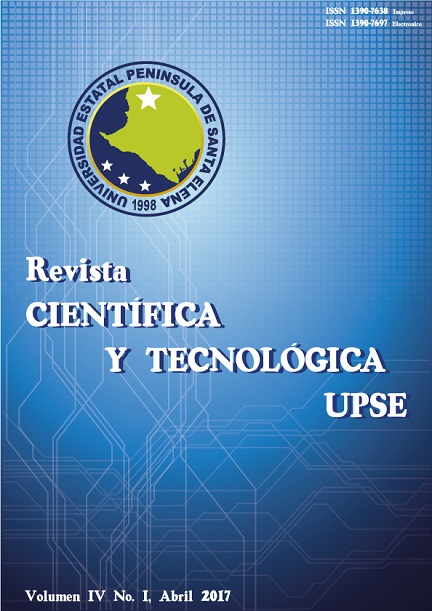Design of an instant messaging application for geolocation of victims trapped after an earthquake
DOI:
https://doi.org/10.26423/rctu.v4i1.224Keywords:
Mobile apps (Apps), Instant messaging, Geolocation, Cell Autonomy, Emerging mobile applicationsAbstract
The present study performs an analysis of the requirements of user-centered design for an instant messaging application whose focus is the geolocation of victims. The design consists of two stages, the first stage focused on obtaining Guides and Insights based on testimony of people with some degree of relation to the victims of the earthquake of April 16 happened in Ecuador, the initial proposal suggested an application to be Executed with the minimum effort of the user in attention to the possible environment that a trapped victim can experience after an earthquake, the initial tests determined that the efforts of design were not enough to fulfill the objectives proposed and a second stage with a design was added Conceptual, which contemplated activation by voice commands; With this, it was possible to determine that there is no relation between the physical structure of the person trapped, nor the enclaustrado means in which it can be found, unlike the security with which it could emit the voice commands that determined the amount of times that A command must be repeated before executing the application.
Downloads
References
SNGR, “INFORME DE SITUACION N°71 del 19/05/2016 (20h30) Terremoto 7.8 ° -Pedernales,” Quito, 2016.
S. Zorn, R. Rose, A. Goetz, and R. Weigel, “A novel technique for mobile phone localization for search and rescue applications,” in 2010 International Conference on Indoor Positioning and Indoor Navigation, 2010, pp. 1–4.
D. Gritzalis, S. De Capitani di Vimercati, P. Samarati, and S. Katsikas, Security and Privacy in the Age of Uncertainty.2003.
D. Klitou, Privacy-Invading Technologies and Privacy by Design, vol. 25. 2014.
H. Khalid, E. Shihab, M. Nagappan, and A. E. Hassan, “What do mobile app users complain about?,” IEEE Softw., vol. 32, no. 3, pp. 70–77, 2015.
A. Martínez D, “Cómo localizar a su familiar con Alzheimer por GPS,” web, 2015. [Online]. Available: http://www.alzfae.org/cuidador/139-ayudas-tecnicas/como-localizar-a-su-familiar-con-alzheimer-por-gps. [Accessed: 03-Jun-2016].
V. Calluzzo and C. Cante, “Ethics in information technology and software use,” J. Bus. Ethics, vol. 51, no. Computerworld 37, pp. 301–312, 2004.
F. Gao, W. Kihal, N. Le Meur, M. Souris, and S. Deguen, “Assessment of the spatial accessibility to health professionals at French census block level.,” Int. J. Equity Health, vol. 15, no. 1, p. 125, 2016.
S. Wang, M. Green, and M. Malkawa, “localizations standars y servicios comerciales.pdf.”.
SNGR, “Informe de situación No. 64 (11/05/2016) 18H00 Terremoto 7.8 ° Pedernales,” Pedernales, 2016.
Samper Esther, Los límites extremos del cuerpo humano, N.A. N.A: MedTempus, 2010.
B. Martin and B. Hanington, “Universal Methods of Design,” pp. 2–480, 2012.
V. Wang, F. Salim, and P. Moskovits, “Building Instant Messaging and Chat over WebSocket with XMPP,” in The Definitive Guide to HTML5 WebSocket, Berkeley, CA: Apress, 2013, pp. 61–83.
P. Saint-André, K. Smith, and R. Tronçon, XMPP: the definitive guide: building real-time applications with Jabber technologies. O’Reilly, 2009.
S. G. Danko, N. P. Bechtereva, N. V Shemyakina, and L. V Antonova, “Electroencephalographic Correlates of Mental Performance of Emotional Autobiographic and Scenic Situations: II. Characteristics of Spatial Synchronization,” Hum. Physiol., vol. 29, no. 6, pp. 685–693, 2003.
J. R. C. Kuntz, K. Näswall, and A. Bockett, “Keep calm and carry on? An investigation of teacher burnout in a post-disaster context,” NZ. J. Psychol., vol. 42, no. 2, pp. 57–68, 2013.
D. O. Baloye and L. G. Palamuleni, “A comparative land use-based analysis of noise pollution levels in selected urban centers of Nigeria,” Int. J. Environ. Res. Public Health, vol. 12, no. 10, pp. 12225–12246, 2015.
N. A. Borghese, P. L. Lanzi, R. Mainetti, M. Pirovano, and E. Surer, “Advances in Neural Networks: Computational and Theoretical Issues,” Smart Innov. Syst. Technol., vol. 37, no. JUNE, pp. 243–251, 2015.
P. M. Commarford and J. R. Lewis, “Models of throughput rates for dictation and voice spelling for handheld devices,” Int. J. Speech Technol., vol. 7, no. 1, pp. 69–79, 2004.
D. S. Pallet, W. M. Fisher, and J. G. Fiscus, “Tools for the analysis of benchmark speech recognition tests,” in International Conference on Acoustics, Speech, and Signal Processing, 1990, pp. 97–100.
Downloads
Published
Issue
Section
License
El titular de los derechos de autor de la obra, otorga derechos de uso a los lectores mediante la licencia Creative Commons Atribución-NoComercial-CompartirIgual 4.0 Internacional. Esto permite el acceso gratuito inmediato a la obra y permite a cualquier usuario leer, descargar, copiar, distribuir, imprimir, buscar o vincular a los textos completos de los artículos, rastrearlos para su indexación, pasarlos como datos al software o usarlos para cualquier otro propósito legal.
Cuando la obra es aprobada y aceptada para su publicación, los autores conservan los derechos de autor sin restricciones, cediendo únicamente los derechos de reproducción, distribución para su explotación en formato de papel, así como en cualquier otro soporte magnético, óptico y digital.












